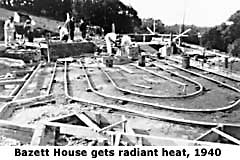The Bazett House - Hillsborough - Page 2
The Bazetts appeared disappointed with several of the preliminary sketches that arrived in May, but remained optimistic. "There is no question that the plans possess beauty and charm," wrote Sidney to Mr. Wright's secretary, Eugene Masselink, "but we do feel that the plan proposed is not suited to the property, climate, our requirements, and our pocketbook." In particular, he cited the positioning of the driveway and the selection of a pitched, 'Tahoe-type' roof. "We are in a warm California climate," he reminded his architect, requesting a horizontal roof line close to the ground. Ever the businessman, Bazett kindly withheld the expected three percent deposit, and asked that Wright personally visit the site.
Wright responded quickly, agreeing wholeheartedly with his clients. "I've returned from Paris and Dubrovnik, and see how a good idea can miscarry in my absence," he wrote, seeming surprised with his firm's performance. "You are right about the unsuitability of the house." Returning two weeks later with revamped designs, Wright felt compelled to show his own excitement. "Here is the result," he wrote. "I like it more than a little...A fresh design for living...Ideal for your climate." The Bazetts chimed in. "It is perfect, and we are in love with the house already,' they responded excitedly. The excitement likely mounted a month later when the couple received news that Louise was pregnant.
Having agreed on a design, Bazett turned his concerns to the final working plans, scheduling, and the management of building costs. Fearful of the rainy season ahead, he pushed to commence construction in August 1939, but delays persisted. The drawings arrived in September, at which time Bazett hired Oscar Cavanagh, a builder based in San Mateo. Bazett agreed with Wright's suggestion to hire an architect's assistant from his fellowship to supervise construction, thus "not only saving our clients cost of the general contractor fee but get the results of which we can be proud of."
In spite of his good intentions, when Wright revised the cost projections in October, the figure had climbed to as much as $12,000, leaving Bazett scrambling to cut back. As Blaine Drake, Wright's assistant, arrived in February, costs had risen an additional $750, and Bazett looked to his architect for relief. "All of this is placing a much heavier burden on me than I had anticipated," he wrote, asking Wright to find an opening to shave expenses.
By the time construction began in March 1940, the Bazetts had rented a larger house, in San Mateo, only four minutes from the construction site, to accommodate Drake and be close at hand as their new home unfolded. Drake proved to be a most capable supervisor, easing the concerns of the Bazetts and moving construction along quickly. He reported faithfully to Wright, mailing weekly letters and payments, and even expressing his growing fondness for his clients.

"Mr. Bazett...sees the completion of a contract more important than the beauty a few more dollars would bring to the house," Drake wrote to Wright early in the construction. But later, he saw his client in a different light when he reported, "Mr. Bazett finally realized that up to now he has had more confidence in [general contractor] Cavanagh than in his architect. And now, realizing you were working for his ultimate good, he endorses the fulfillment of your design."
The price of fulfillment, however, was almost twice the original budget at the close of construction in June. Even though financial bickering lingered, the Bazetts, and in particular Louise, seemed thoroughly happy with the results. "We truly have more of a home than we had ever hoped for," she told Wright. However, all was not joyful. As their new home was about to come to life, their baby arrived stillborn. And six months later the U.S. had entered the war.
Betty and Louis Frank knew none of this history when, as the war came to a close, they bought the Bazett house in April 1945. For the previous three years, the Franks had been living in a tiny duplex in the San Mateo lowlands, but Betty's respiratory condition, aggravated by winds, forced the couple to look to the sheltered hills for relief.
The Franks had been looking for a home in Belmont and San Carlos for more than a year when their realtor drove them to Hillsborough, and to the Bazett house, which had been on the market for almost a year. In Sidney Bazett's absence, the house had been rented to Joe Eichler and his family since early 1943. Eichler was absolutely in love with the house, which had introduced him to a new and engaging way of life, but his family's troubled butter-and-egg business and a trying relationship with Mr. Bazett stood in the way of his own purchase.




